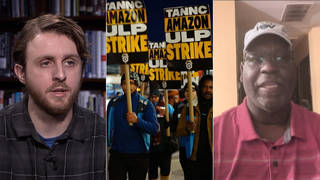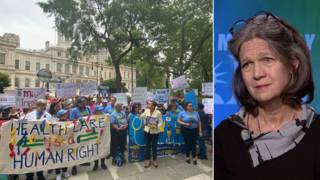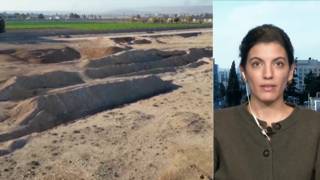
Related
Guests
- Laura Carlsendirector of the Mexico City-based Americas Policy Program of the Center for International Policy.
- John Giblerauthor and independent journalist based in Mexico. He is the author of Mexico Unconquered: Chronicles of Power and Revolt and, more recently, To Die in Mexico: Dispatches from Inside the Drug War.
Amidst outrage in Mexico over the disappearance of 43 students, we look at the U.S. role in the country’s violence. According to the Center for International Policy, the United States has spent approximately $3 billion to fund the so-called war on drugs in Mexico. Since the war on drugs began under President Felipe Calderón in 2006, more than 100,000 people have been killed in drug-related violence. U.S. support includes $2.4 billion in taxpayer funds through the Merida Initiative, launched as a three-year aid program for Mexican security forces under the administration of George W. Bush. The Obama administration has extended the Merida Initiative “indefinitely.” We are joined by Laura Carlsen, director of the Mexico City-based Americas Policy Program of the Center for International Policy, and journalist John Gibler.
Transcript
NERMEEN SHAIKH: We are talking about the disappearance of 43 students at the hands of the police in the southern Mexican state of Guerrero. This is Ernesto Che Cano, a first-year student at Ayotzinapa teachers college who survived the police attack. He’s responding to the claim by Attorney General Jesús Murillo Karam that the students were killed and their bodies burned by a local drug gang.
ERNESTO CHE CANO: [translated] He’s just doing this to wash his hands of the problem and appear that he’s doing something. It’s obvious that it is not that way. It is obvious that the attorney general just seems like he is looking for the compañeros. One thing that really bothers me is that this personality, the attorney general, Murillo Karam, and all the other people in charge of looking for my compañeros, are looking for them as if they are dead instead of alive. If the municipal police took away my compañeros while they were alive, why the heck are those people looking for them dead?
NERMEEN SHAIKH: That was Ernesto Che Cano, a first-year student at Ayotzinapa teachers college. This is Omar García, another student from the school who survived the police attack.
OMAR GARCÍA: [translated] We hope the actions get more intense, so that it is not just all talk. We need real action. We don’t have anything against the buildings or the street pavement. We have everything against the institutions, against the government structure. We want to change this country. We want people who are within these institutions to be honest people, people from our communities, not just people who are there for their own interests. Right now, they are just making it a political issue, pitting one against another, saying, “You knew the mayor,” “I went to a dance with him,” or “You went out drinking with him.” All are involved in some way, including we as a society. We have been accomplices for closing our eyes and keeping silent. We have to end this complicity.
AMY GOODMAN: Special thanks to Andalusia Knoll for this footage, as she is in Guerrero covering these protests. John Gibler with us, author, independent journalist in Mexico, author of Mexico Unconquered, as well as, more recently, To Die in Mexico: Dispatches from Inside the Drug War. As you hear these students talking, the students of the teachers college that was attacked, we still don’t understand—on the day that this happened, why did the mayor have the police round up these students? What was going on that day in town?
JOHN GIBLER: We still don’t know why, what the mayor was thinking. His statements to the press have been cynical and obviously laden with lies. From the students’ behalf, we should recall that there was never a protest, even though that’s been widely repeated in the English-language press. There was no plan to go to Iguala to interrupt the mayor’s wife’s ceremony. Most of the students who were attacked that night were freshmen. They had been at Ayotzinapa for only a matter of weeks. In fact, that Friday, for many, it was their first day of classes. So, these people, who come from some of the most economically battered municipalities in Mexico, and perhaps in the Western Hemisphere, had no idea who the mayor of Iguala was.
I think what happened speaks to two things. One, it shows the full merger between police forces and local governance and organized crime. I don’t think it’s possible anymore to talk about corruption. The idea of corruption no longer has any kind of descriptive power. But what we have is two sectors of an industry that have fully merged—the police and the drug or organized crime gangs themselves—and the confluence of two forms of violence—the classic state violence of repression and the kind of newish forms of narcobrutality, the violence associated with organized crime organizations here.
Again, the police attack to round up, detain, beat, arrest, perhaps shoot a few students, this is something that’s been going on against the Ayotzinapa students for years. In fact, on December 12, 2011, state police shot and killed, during a protest action on the highway, two students. That case still remains also in impunity. No one has been punished. But also, the mix with the forms of terror—forced disappearance has a long and sordid history as a practice of state violence in Mexico, but very particularly in Guerrero, which during the so-called Dirty War of the 1970s, half of the people disappeared in Mexico were disappeared in Guerrero state. So that’s a long-standing state practice of violence. But this removal of Julio César Mondragón’s face, the gouging out of his eyes, the displaying of that body, I think testifies or shows the merger, confluence of state violence and so-called narcoviolence.
AMY GOODMAN: On Friday, Mexico’s attorney general, Jesús Murillo Karam, gave the spreading outrage a new rallying cry, when he ended his news conference in Mexico City by saying, ”Ya me cansé,” “Enough, I’m tired.” The remark has been taken up by protesters who see the attack in Iguala as part of the systematic failure by the state. Filmmaker Natalia Beristáin was among hundreds who posted videos with the hashtag #YaMeCanse.
NATALIA BERISTÁIN: [translated] Señor Murillo Karam, I am Natalia Beristáin, and I, too, am tired. I’m tired of disappeared Mexicans, of the femicides, of the dead, of the decapitated, of the bodies hanging from bridges, of the broken families, of the mothers without children, of the children without parents. I’m tired of the political class that has kidnapped my country and of the class that corrupts, that lies, that kills. I, too, am tired.
AMY GOODMAN: On Monday, the attorney general, Murillo Karam, appeared on national television and said he does not regret his gaffe.
CARLOS LORET DE MOLA: [translated] Was it a bad phrase?
ATTORNEY GENERAL JESÚS MURILLO KARAM: [translated] No. I was tired, and it was the truth.
CARLOS LORET DE MOLA: [translated] Would you say it again?
ATTORNEY GENERAL JESÚS MURILLO KARAM: [translated] Naturally, I don’t need to lie. I’m as human as anybody, and I also get tired. I have been sleeping four hours for the past 30 days. And on that day, I hadn’t slept for 40. I had also traveled from Chilpancingo. And the truth is, when you listen to them, the relatives of the students, it affects you when faced with helplessness, of not being able to give them an immediate truth.
AMY GOODMAN: So, John Gibler, there’s the Mexican attorney general. The president, Peña Nieto, is with—went to China with President Obama, with the meeting—with the meetings of APEC. Can you talk about what is going on at state level with Peña Nieto in Mexico facing enormous criticism for leaving in the midst of this crisis to attend the APEC summit in China, also under scrutiny following revelations he and his wife possess a $7 million mansion designed for them by a company that has received lucrative government contracts? The company, Grupo Higa, is part of a consortium that won a lucrative high-speed rail contract, last week the Mexican government abruptly reversing the deal following outrage the consortium was the only bidder, the one that built their mansion. Peña Nieto has been championed in the U.S. press for his neoliberal reforms, appearing on the cover of Time magazine earlier this year with the headline, “Saving Mexico.” So, can you put this in this broader context? How does this crisis reflect on him and what’s happening in Mexico, John, as the Mexican ambassador to the United States this morning said, “We are all together holding those accountable. We have arrested more than 70 people,” he said, “including the mayor and his wife,” etc.?
JOHN GIBLER: I think this is the first major kind of crack in Peña Nieto’s veneer. He had been enjoying a kind of love affair with the international press, which I think is epitomized by the Time magazine cover. He was presented—Peña Nieto was presented as the president of reforms, energy and education reforms. He had busted an old-school corrupt union boss. He had grabbed El Chapo. It seemed like everybody, especially, again, in the English-language press, was in love with Peña Nieto. But now, with municipal police, ordered by the mayor, rounding up, murdering, disappearing students, leaving six people dead, 43 disappeared, the army base three miles away and the army never interceding on behalf of the victims, it completely destroys the myth of a Mexico that had been “saved,” to quote Time magazine, by this political official.
And again, as Ernesto, the young survivor of the attacks, had said, what’s most outraged the parents, the survivors and the classmates of the 43 disappeared has precisely been that the government, after weeks of ineptitude and foot dragging, when they finally started looking for the students, they looked for them in mass graves. They looked for them dead, in the forms of bones and ash. And the parents are very intense and clear in their demands: “The students were taken away alive by the police. Bring them back alive.”
And so, the attorney general’s statements that he’s tired can only seem violent and ridiculous. Imagine how the 43 sets of families feel, what they—how much sleep did they get at night? And the president’s, you know, just insane luxury home, officially registered with this company that he’s gotten contracts for, that news breaking as these families are looking for their children—and recall that these families are from some of the most marginalized places in Mexico. Literally, the state of Guerrero has the top ranking so-called poorest municipalities in the country, so families that live in hand-built, adobe and wood constructions in very small rural communities. Then you have the president’s slick, multimillion-dollar home displayed on television screens and magazines at a time when these people are camping out on a basketball court at a small rural college, waiting for their children to be returned alive. It’s outrageous.
NERMEEN SHAIKH: I want to turn to the U.S. role in the violence that’s ravaging Mexico. The United States has spent approximately $3 billion to fund the so-called war on drugs in Mexico. Since the war on drugs began under President Felipe Calderón in 2006, more than 100,000 people have been killed in drug-related violence. We’re joined now in Mexico City by Laura Carlsen, director of the Mexico City-based Americas Policy Program of the Center for International Policy.
Welcome to Democracy Now!, Laura Carlsen. Can you talk about the role of the U.S. in the crisis that’s unfolding in Mexico today?
LAURA CARLSEN: Good morning. Yes, the United States has a fairly direct role in what’s happening today. And as the students begin and youth begin to analyze it, it’s becoming a major issue in terms of how far they’ll be able to change the model. Besides the nearly $3 billion that’s come through the Merida Initiative, there’s also Department of Defense money, and that money is going to train police forces and armed forces, that now we find are directly involved in attacks on the people, and particularly attacks on youth. We mentioned the case of Tlatlaya, where 22 youth were—now, it seems, by all evidence available—actually executed by the armed forces. And the State Department has admitted that in that battalion, although we don’t know because they won’t give us the names, there are five individuals that were trained in the United States. So there’s been a call for a long time to stop the Merida Initiative precisely for this reason, because of what John mentioned, that the state agents, at this point, in Mexico and organized crime are one in the same in many, many parts of the country.
AMY GOODMAN: And the meeting—presumably, President Obama spoke with President Peña Nieto in China in this meeting that they’re having around the Asia-Pacific Economic Cooperation summit. What do you think, Laura Carlsen, needs to be done? Where is the accountability for this—where this money goes, in this connection between the police forces, the drug gangs, in fact, often indistinguishable? And how high up does this go?
LAURA CARLSEN: Well, the main point, at this point, that President Obama and President Peña Nieto—John mentioned the problem that he seems to have been more dedicated, by far, to damage control than to ever resolving the problem here in Mexico, and there’s a reason for that. The main thing that both of them are concerned with is foreign investment. Mexico, with the reforms under Peña Nieto, that the Ayotzinapa students were very active in protesting, by the way, which is a big part of why they’ve been targeted, as well, is now betting the entire country on foreign investment, especially in the newly opened oil and gas area. And President Obama and the Mexican government and the transnational corporations that are based in the U.S. have been pushing this, and it’s one of the reasons they created this very false image of everything’s great and modern, and Peña Nieto is the great reformer in Mexico, that has now been completely shattered by the revelations not just of the 43 students, but the mass graves and the disappearances and the corruption and collusion throughout the country.
So, right now, first of all, in the United States, all funding to these police and military forces through this drug war model, which has militarized the country and created a new model for repression against youth and against opposition, must be cut off immediately, or we’re directly responsible for future crimes which will occur. And on the Mexican side, the call in all these marches—and I’ve been to giant marches, 50,000, 100,000. There’s assemblies in UNAM. We’ve been to four or five in which students are already planning what to do to force the resignation of Peña Nieto. The idea is, if there’s a country where there can be mass graves, if there’s a country where 43 students can go missing at the hands of state agents, then something is so deeply wrong that the government needs to be changed completely and the whole system needs to be changed. So there are constant discussions to try to figure out how to do that. But there is a very firm commitment on the part of these protests that whatever happens in terms of the fate of the students right now, it will not end there.
NERMEEN SHAIKH: And do you think, Laura Carlsen, that police in Iguala could have benefited from U.S. funds?
LAURA CARLSEN: Yeah, it’s very possible. There’s a fund for municipal security, for example, that they received 80 million pesos from. But we’re having a very hard time tracking it, because we can’t get the information for the State Department or the Mexican government to make direct ties. But it doesn’t matter, in the broader sense, because what we know is that the United States is funding this drug war to support security forces that it turns out are in deep collusion with the criminal forces and that in fact this collusion is directed against the population, instead of being the “good guy” government against the “bad guy” drug cartels. And so, even if you don’t find the smoking gun or the exact ties between this dollar went to this government agency, we know it’s there. And, in fact, the Merida Initiative lately has explicitly gone more toward municipal funding, which is even more problematic in Mexico, because that’s where you find the highest levels of direct collusion.
NERMEEN SHAIKH: Could you explain, Laura Carlsen, what the Merida Initiative is?
LAURA CARLSEN: Yeah, the Merida Initiative was started by the Bush administration. In 2007, it was announced as a counternarcotics, counterterrorism and border security initiative, and then was funded in 2008. And the Obama administration, instead of coming in after the three-year initiative ran out and saying, “Well, what are the results of this?”—we already knew that the results were increased violence in Mexico—announced that it would be extended indefinitely. And indeed that’s what’s happened. So, this goes to training police forces. At the beginning, it went to funding a lot of big-ticket military equipment.
There’s a constant lobbying effort on the part of defense companies, intelligence companies and private security firms in the United States to perpetuate the Merida Initiative and to perpetuate the drug war in Mexico. And it seems to have no impact whatsoever that we can go and say to Congress, “There’s a direct correlation between this model and 100,000 people dead. This is not working. It’s not only not working; it’s completely dangerously counterproductive.” No matter how often that’s said, there is still this impetus to continue because of the money that’s involved and because of the Pentagon’s interest, through this vehicle of the drug war, to have a far stronger hand in Mexico. You know, it’s part of this concept that Mexico now forms part of the U.S. security parameter, which says a lot about the disregard for Mexican sovereignty, and it’s also put Mexico in this position of doing the United States’ dirty work to enforce prohibition laws in the United States at this incredibly high social cost for Mexico.
AMY GOODMAN: And the very much hailed program of President Peña Nieto around energy that so benefits U.S. multinational corporations—oil companies, in particular—how will that impact how the U.S. deals with Mexico on this issue, and, ultimately now, how you see this resolving, Laura?
LAURA CARLSEN: Well, it will have a tremendous impact, because what this means is—in the first place, it means that in Mexico, where there’s concessions for oil, just as we’ve seen where there have been concessions for mining in recent years, it means that the government will want to have complete territorial control, that guarantees that those businesses and those corporations will be able to extract and make a lot of money off Mexican natural resources. This is a big problem, because they’ll be taking over resources that actually belong to the people. And we will see resistance, because the Mexican people in the farming communities are not going to just allow this to happen with their land.
And then, in terms of what’s happening with the binational relationship, you know, we’ve talked before about this whole process of arming NAFTA, which means that there’s a series of mechanisms—the drug war being the most important—that are really aimed at militarizing the country in order to protect foreign investment. So, as that becomes even more intensified with the greater investment in oil and gas, including fracking, including things that are going to be devastating to Mexican communities and to the Mexican environment, there’s going to be more emphasis on the militarization, not to fight the drug cartels, because they haven’t even really been doing that, and certainly not been doing that effectively, but to fight the resistance of the people to the takeover of their lands and resources.
AMY GOODMAN: John Gibler, final comment, as you take this back home to Guerrero, where there is so much strife, not to say this hasn’t ignited all of Mexico?
JOHN GIBLER: I think, first off, Laura’s point about the lobbyists constantly pushing for the continuation of the Merida Initiative, I think that’s excellent. It recalls, I think, our necessity to analyze how the drug war is designed to perpetuate itself. The drug war is built to fuel the drug war, not to stop drug production, trafficking or consumption, not to address real public health issues, but to create these very forms of violence, which require further military intervention.
And then, as a last point, I’d like to recall some of the words from the open letter from protesters and allies in Ferguson, which have really been resonating for me as I’ve been attending the recent protests in Guerrero, where from Ferguson they wrote, “We are not concerned if this inconveniences you. Dead children are more than an inconvenience. We are not concerned if this disturbs your comfort. Freedom outweighs that privilege.”
AMY GOODMAN: John Gibler, we want to thank you for being with us, author, independent journalist, speaking to us from Guerrero. He’s the author of Mexico Unconquered: Chronicles of Power and Revolt and, more recently, To Die in Mexico: Dispatches from Inside the Drug War. And, Laura, thank you, as well, director of the Mexico City-based Americas Policy Program for the Center for International Policy. Laura Carlsen was speaking to us from Mexico City.
This is Democracy Now!, democracynow.org, The War and Peace Report. And speaking of Ferguson, as the parents of Michael Brown testify in Geneva before the U.N. Human Rights Council around the issue of torture, we’re going to come back home in our next segment, and we’re going to look at the issue that African-American boys, girls, men and women face in this country with Professor Kimberlé Crenshaw. Stay with us.












Media Options